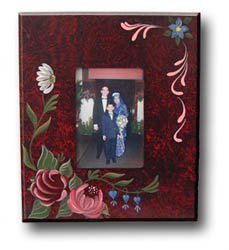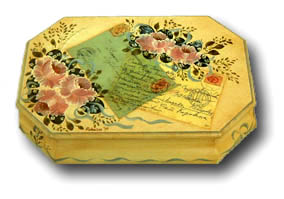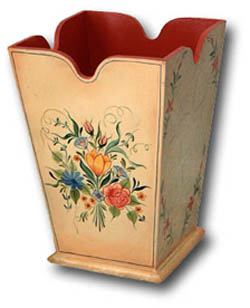Bauernmalerei Bauernmalerei
(pronounced bow-urn-maler-rye) is folk art associated with Germany,
Austria and Switzerland. The term comes from two words: "bauern" which
means peasant or farmer and "malerei" which means painting.
In reality, the farmers and peasants hardly did any painting
- they were too busy in the fields and in fact were customers
to travelling painters and cabinetmakers. It originated in the Bavarian and Austrian
Alps and the Swiss Apenzell and is therefore also commonly referred
to as "Bavarian Folk Art". Although Bauernmalerei began as something
very simple and naive, it has undergone many phases of evolution. 
A beginner bauernmalerei project.
A very simple design with all the elements of bauernmalerei. The
background is faux leather achieved using the technique of sponging-off. Trends in art and architecture
exerted heavy influences and various styles of Bauernmalerei emerged
between the 17th century and the 19th century. Each period - The
Renaissance Period (17th Century), The Baroque Period (1700 - 1800),
The Rococo Era (circa 1750), The Empire Era and The Biedermeier
Era (up to the mid-19th century) - brought with it influences which
affected the type of backgrounds painted on - raw, painted or faux
finished, the way the designs were arranged - symmetrical or asymmetrical,
the type of flowers and objects painted as well as colors used.

A bombay box on which
antique postcards were decoupaged and then painted with multi-loaded
roses in the Bauernmalerei style. This was a project painted
with well known multi-loading artist, Lea Davis.

Multi-loaded
roses and a dove painted on a maroon background in this simple
Bauernmalerei project.
Regional variations of Bauernmalerei There were many regional variations as the
art spread throughout Europe from village to village. Master craftsmen
applied their preferred techniques and styles to individualize
their painted decoration. The Tolzer Style originated from a
town called Bad Tolz in Southern Germany. The most famous is the
Tolzer Rose which has become a favourite with many folk artists.
The style is easy and is ideal for beginners. The Rossler Style was painted mainly
on schranks, beds and trunks by painters in a village just north
of Stuttgart. This style features not only flowers but also animals
and peasant scenes, fruit baskets, hearts and swirls. The painting
is generally naive with a combination of blues and greens as backgrounds
and characteristic red borders. The Wismut Style was associated with "wismut" which
is a metal mined in the Erz mountains of Germany. It was applied
as background on small chests to imitate the silver chests of the
wealthy after which flowers were painted on them. Figures in old
costumes and beautiful borders around the edges are also featured
on some trunks. The Hessian Style - only
trunks are painted in the Hessian style. The backgrounds were usually
medium to a very dark blue. Flowers and borders on these pieces
are usually quite primitive.
The Franconian Style is
associated with Franconia, the northern region of Bavaria. The
vases and flowers painted in this style are not as elaborate as
those painted in lower Bavaria but are still rather pretty. "Peasant
marble" also features in this style. 
A round box with a Franconian design by Lia which
I painted as a wedding gift . The sides of the box are painted with
blue and
white scrolls.
The Black Forest Style In
the southwest corner of Germany, bordering Switzerland and France,
lies an area called Black Forest - in German - Schwarzwald. The kind of painting
originating from this region is very different and resembles
porcelain painting. Everywhere else in Germany white overstrokes
are used as highlights on flowers, here the white from the background
comes through as a highlight. Most of the time the background is
painted in either off-white or an almost black.

A small
bin painted in the Black Forest style. Features colour washes and
linework. The corners were antiqued to give it an aged look.
|